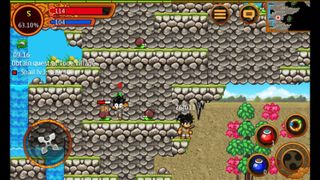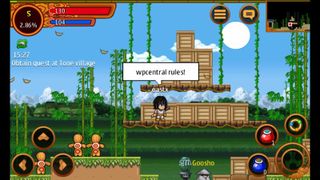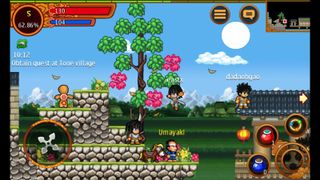Ninja School review – MMO platformer and Windows Phone's answer to Maple Story

A while back we reviewed Spirit of Hero, a 3D MMORPG (Massively Multiplayer Online Role-Playing Game) from Vietnamese developer TeaMobi. Although fairly buggy and riddled with translation errors, the game offered a lot of content and a unique look at Vietnamese history and mythology. And there aren’t exactly tons of free to play MMORPGs on Windows Phone.
It turns out that TeaMobi is something of an MMO specialist. They offer two more massively multiplayer online games on our favorite smartphone platform: Ninja School and Avatar. Today we look at Ninja School (aka Ninja School Online), a free platforming RPG similar to the popular Maple Story series. Surprisingly, this one works with both Windows Phone 7 and 8. Do technical problems and poor translation keep this game from ninja awesomeness? Find out in our full review.
Create a ninja

After launching the game, players will choose between Vietnamese and English (or should I say Engrish) languages. You’ll then have to create an account for the game. Annoyingly, Ninja School recognizes my login details from Spirit of Hero but will NOT allow me to actually use that account. So I had to create a different account – a needless hassle.
Next you’ll arrive at a screen consisting of three blank boxes and no text. It turns out this is the character selection screen; I guess somebody forgot to label it. Just pick a box and you can create a 2D ninja of your very own. The selection of parts is disappointingly slim. You’ll just choose a gender and hairstyle, and that’s it. At least we don’t have to select a seemingly meaningless attribute (unlike Spirit of Hero).
Next comes server selection. Choose from four servers. None are named by location, so we have no criteria by which to make the selection. I bet they’re all located in Vietnam anyway.
Ancient Japanese village

Once the actual game begins, your ninja appears in lovely a 2D village set within feudal Japan. The village is populated with both NPCs (non-player characters) and other players running about their ninja business. Everything is colorful and fairly well drawn, and the backgrounds are filled with layers of parallax (independently scrolling layers). It’s quite a visual treat, although slightly less so than the real Maple Story.
Unlike Spirit of Hero, there’s no introductory story to explain your overall mission. But you do endure a very similar first quest: talking to all the NPCs of the village. Each one performs a different function such as selling food or providing transport to other areas. Language issues aside, you’ll have to speak to each NPC in a particular order, so pay attention to the mission description on the left side of the screen.
Get the Windows Central Newsletter
All the latest news, reviews, and guides for Windows and Xbox diehards.
The NPCs all speak in utterly terrible English, full of spelling, grammatical, and capitalization errors. TeaMobi badly needs to hire a native English speaker to proofread their text. On the plus side, Ninja School’s characters have much less awful names than those of Spirit of Hero.
The next mission actually quizzes players on the function of each NPC, which is both pedantic and boring. Complete it to get a sword, which you’ll use to chop down hapless “scarecrows” (actually training dummies) throughout the village. Then you’ll finally unlock access to the outside areas and actual enemies, but only after buying and eating some Onigiri from a vendor.
Ninja combat

Ninja School’s training missions are aggressively dull and run the risk of scaring off new players. Stick with it though and you’ll find the combat areas are much more enjoyable. The controls take some getting used to, though. There is no jump button like you’d expect from a platformer. Instead, you press up on the virtual d-pad to jump. I found that switching to the virtual analog stick in the Config menu (found under the “General” menu) made walking and jumping a lot more pleasant.
On the right side of the screen, you have an interaction button that doubles as attack. Surrounding it are three more buttons: two for potions and one that switches between different characters to target. The fighting is simple but fun; just run up to enemies like snails and frogs (misspelled as “fog” within the game) and whack away. Sometimes my character would continue attacking even if I stopped pressing the button, but not others. I suspect there’s a way to intentionally keep the attacks going.
Although I got used to the controls after a while, they still need improvement. And MOGA controller support would be a wonderful addition. However, this appears to be a Windows Phone 7 game so MOGA support wouldn't be technically possible.
Social features

People play MMOs for different reasons. One of those is to meet other players and socialize with them. One thing I can say in this game’s favor is that it feels well-populated. You’ll encounter lots of live players in the starting town and surrounding areas, selling the idea that you’re in an MMO instead of a single-player game. If there are instanced zones, I haven’t seen them yet.
That said, Ninja School’s chat system is just as bad as Spirit of Hero’s. Both games lack a global chat option. Any chat messages you type will be visible only to nearby players, not everybody.
You can add people to a friends list, but the process for doing so is unintuitive. After tapping and selecting another player or switching to them with the aforementioned targeting button, a life meter appears below his or her name. Tap the interaction button and your ninja will run over to the target, at which point a poorly-formatted context menu finally pops up. You can use it to befriend, trade, chat, fight, and party up with the other player.
Ninja School appears to support clans as well – you can view your own clan info from within the “General” menu. But I haven’t found the option to edit that info or actually create a clan. Either the feature has yet to be implemented or I just haven’t unlocked it so far.
In-app purchases

Ninja School has two forms of currency: kin and coins. Kin appears to be a shortening of bundōkin, a form of currency in 16th century Japan. It could also be a fictional currency, or just a translation mistake. Hard to say with games from this particular developer. Anyway, kin is the soft currency that you’ll earn from completing missions. I haven’t encountered a way to purchase or use coins yet, but coins are likely a premium currency.
Loving an imperfect ninja
Ninja School has a lot of things going against it: connection issues, awkward controls, and super poor translation. The translation is actually worse than in Spirit Hero, in fact. You’ll sometimes encounter Vietnamese text in places, even having chosen English at the game’s onset. And yes, these language issues (and awkward menus) make playing the game harder than it should be.
But! The design of the game itself actually won me over here, unlike Spirit of Hero. This is the only MMO platformer on Windows Phone, and that’s a fascinating and addictive style of game. Exploring beautiful 2D environments and encountering other players’ cute ninjas along the way is my idea of a good time. So if you’re a fan of platformers (and/or Maple Story), Ninja School is definitely worth a try.
- Ninja School – Windows Phone 7 and 8 – 17 MB – Free – Store Link

Paul Acevedo is the Games Editor at Windows Central. A lifelong gamer, he has written about videogames for over 15 years and reviewed over 350 games for our site. Follow him on Twitter @PaulRAcevedo. Don’t hate. Appreciate!

